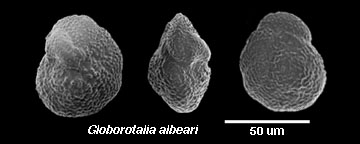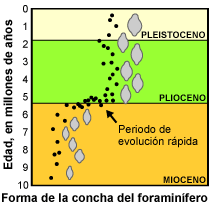Cuando hay organismos que dejan un registro fósil especialmente denso a lo largo del tiempo (es decir, un registro con pocos huecos de una duración considerable), los científicos pueden examinar directamente la velocidad del cambio evolutivo. Los foraminíferos son organismos acuáticos unicelulares muy comunes y que construyen conchas, un conjunto de características que ha hecho que dejen un abundante registro fósil.


El gráfico de la izquierda muestra la evolución de la forma de la concha en un linaje de foraminíferos durante los últimos 10 millones de años. Como se ve, la mayoría del tiempo la forma de la concha muestra una relativa estasis: cambia un poco, pero no parece que esté cambiando en ninguna dirección determinada la mayor parte del tiempo. Sin embargo, los dos periodos de relativa estasis están divididos por un breve periodo de cambio morfológico rápido, hace unos 5,5 millones de años. Las pruebas como esta son cruciales para evaluar las hipótesis sobre la velocidad del cambio evolutivo.
Original translation by the Spanish Society of Evolutionary Biology; translation editing by Maya deVries
